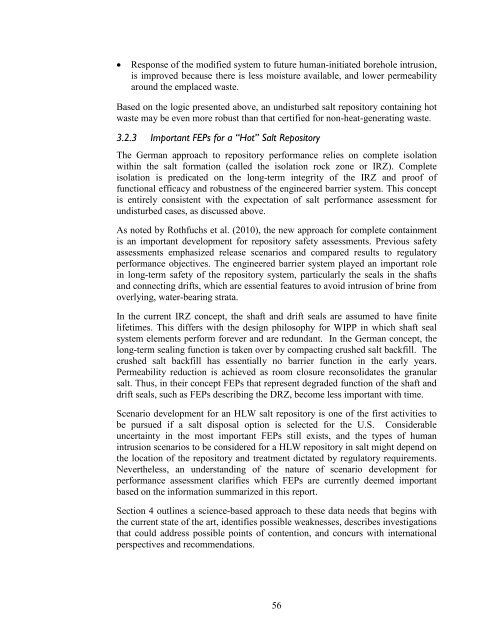Salt Disposal of Heat-Generating Nuclear Waste
Salt Disposal of Heat-Generating Nuclear Waste
Salt Disposal of Heat-Generating Nuclear Waste
Create successful ePaper yourself
Turn your PDF publications into a flip-book with our unique Google optimized e-Paper software.
• Response <strong>of</strong> the modified system to future human-initiated borehole intrusion,<br />
is improved because there is less moisture available, and lower permeability<br />
around the emplaced waste.<br />
Based on the logic presented above, an undisturbed salt repository containing hot<br />
waste may be even more robust than that certified for non-heat-generating waste.<br />
3.2.3 Important FEPs for a “Hot” <strong>Salt</strong> Repository<br />
The German approach to repository performance relies on complete isolation<br />
within the salt formation (called the isolation rock zone or IRZ). Complete<br />
isolation is predicated on the long-term integrity <strong>of</strong> the IRZ and pro<strong>of</strong> <strong>of</strong><br />
functional efficacy and robustness <strong>of</strong> the engineered barrier system. This concept<br />
is entirely consistent with the expectation <strong>of</strong> salt performance assessment for<br />
undisturbed cases, as discussed above.<br />
As noted by Rothfuchs et al. (2010), the new approach for complete containment<br />
is an important development for repository safety assessments. Previous safety<br />
assessments emphasized release scenarios and compared results to regulatory<br />
performance objectives. The engineered barrier system played an important role<br />
in long-term safety <strong>of</strong> the repository system, particularly the seals in the shafts<br />
and connecting drifts, which are essential features to avoid intrusion <strong>of</strong> brine from<br />
overlying, water-bearing strata.<br />
In the current IRZ concept, the shaft and drift seals are assumed to have finite<br />
lifetimes. This differs with the design philosophy for WIPP in which shaft seal<br />
system elements perform forever and are redundant. In the German concept, the<br />
long-term sealing function is taken over by compacting crushed salt backfill. The<br />
crushed salt backfill has essentially no barrier function in the early years.<br />
Permeability reduction is achieved as room closure reconsolidates the granular<br />
salt. Thus, in their concept FEPs that represent degraded function <strong>of</strong> the shaft and<br />
drift seals, such as FEPs describing the DRZ, become less important with time.<br />
Scenario development for an HLW salt repository is one <strong>of</strong> the first activities to<br />
be pursued if a salt disposal option is selected for the U.S. Considerable<br />
uncertainty in the most important FEPs still exists, and the types <strong>of</strong> human<br />
intrusion scenarios to be considered for a HLW repository in salt might depend on<br />
the location <strong>of</strong> the repository and treatment dictated by regulatory requirements.<br />
Nevertheless, an understanding <strong>of</strong> the nature <strong>of</strong> scenario development for<br />
performance assessment clarifies which FEPs are currently deemed important<br />
based on the information summarized in this report.<br />
Section 4 outlines a science-based approach to these data needs that begins with<br />
the current state <strong>of</strong> the art, identifies possible weaknesses, describes investigations<br />
that could address possible points <strong>of</strong> contention, and concurs with international<br />
perspectives and recommendations.<br />
56
















